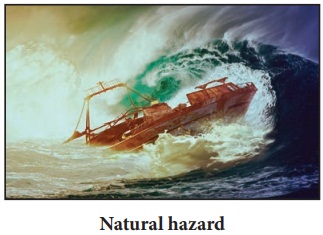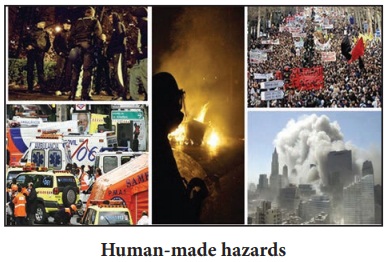Chapter 5 | Geography | 8th Social Science - Types of Hazards | 8th Social Science : Geography : Chapter 5 : Hazards
Chapter: 8th Social Science : Geography : Chapter 5 : Hazards
Types of Hazards
Types of Hazards
Some hazards occur frequently and
threat the people. Hazards are classified in different ways.
I.
Based on their causes of occurrence.
II. Based on their origin.
I. Based on their causes of
occurrence
Hazards can be broadly classified
into three types: natural, human-made and socio-natural hazards.
1. Natural hazards: These are the results of
natural processes and man has no role to play in such hazards. The main
examples of natural hazards are earthquakes, floods, cyclonic storms, droughts,
landslides, tsunamis and volcanic eruptions.

2. Human-made hazards: these are caused by undesirable
activities of human. It can be the result of an accident, such as an industrial
chemical leak or oil spill, or an intentional act. Such hazards can disturb the
safety, health, welfare of people and cause damage or destruction to property.
The following are the examples of human-made hazards. They are explosions,
hazardous wastes, pollution of air, water and land, dam failures, wars or civil
conflicts and terrorism.

3. Socio-natural hazards (Quasi-natural hazards): these are caused by
the combined effect of natural
forces and misdeeds of human. Some of the examples are:
* The frequency and intensity of
floods and droughts may increase due to indiscriminate felling of trees, particularly
in the catchment areas of the rivers.
* Landslides are caused by natural
forces and their frequency, and impact may be aggravated as a result of
construction of roads, houses etc., in mountainous areas, excavating tunnels
and by mining and quarrying.
* Storm surge hazards may be
worsened by the destruction of mangroves.
* Smog is a serious problem in most
big urban areas. The emissions from vehicles and industries,combustion of wood
and coal together combined with fog leads to smog.
II. Based on their origin
Hazards can be grouped into eight
categories
1.
Atmospheric hazard – Tropical
storms, Thunderstorms, Lightning,
Tornadoes, Avalanches, Heat waves, Fog and Forest fire.
2. Geologic/Seismic hazard – Earthquakes, Tsunami, Landslide and Land subsidence.
3. Hydrologic hazard – Floods, Droughts, Coastal
erosion and Storm surges.
4. Volcanic hazard – Eruptions and Lava flows.
5. Environmental hazard – Pollution of soil/ air/water, Desertification, Global
warming and Deforestation.
6. Biological hazard – Chickenpox, Smallpox, AIDS [HIV] and Killer bees.
7. Technological hazard – Hazardous material incidents, Fires, Infrastructure
failures [Bridges, Tunnels, Dams, Nuclear and Radiological accidents].
8. Human-induced hazard – Terrorism, Bomb blast,
War, Transportation accidents and Civil disorder.
Related Topics